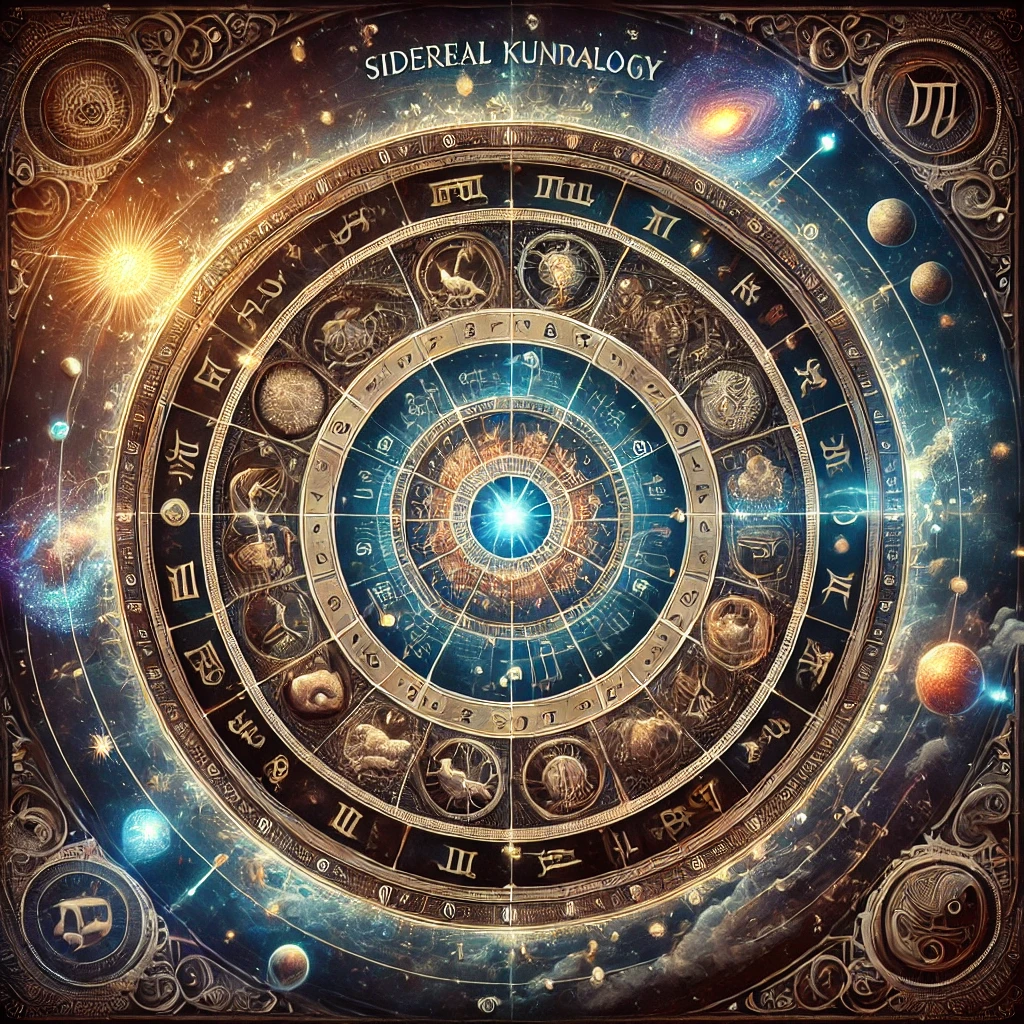Sidereal astrology is an ancient system of astrology that uses the actual positions of the stars and constellations in the sky to interpret the influences of the celestial bodies on human life. Unlike the more widely practiced tropical astrology, which is based on the seasonal cycle of the Sun’s movement, Sidereal astrology takes into account the Earth’s precession, accounting for the gradual shift of the constellations over time. This system is more aligned with the fixed stars and is commonly used in Vedic astrology (Indian astrology), as well as in certain forms of Western astrology that incorporate a sidereal approach.
Key Components of Sidereal Astrology
- Zodiac Signs
In Sidereal astrology, the twelve zodiac signs are determined based on the position of the Sun in relation to the constellations. These signs differ slightly from the Tropical zodiac used in Western astrology because the Sidereal system accounts for the Earth’s precession over a 26,000-year cycle, which causes the stars to shift positions over time. In this system, the signs are shifted backward by roughly 23-24 degrees from their tropical counterparts. - The Twelve Zodiac Signs in Sidereal Astrology
The twelve signs in Sidereal astrology are:- Aries (Mesha)
- Taurus (Vrishabha)
- Gemini (Mithuna)
- Cancer (Karka)
- Leo (Simha)
- Virgo (Kanya)
- Libra (Tula)
- Scorpio (Vrischika)
- Sagittarius (Dhanu)
- Capricorn (Makara)
- Aquarius (Kumbha)
- Pisces (Meena)
- Planets and Constellations
Just like in Tropical astrology, the planets (such as the Sun, Moon, Mercury, Venus, etc.) play an important role in Sidereal astrology. However, Sidereal astrology emphasizes the positions of the planets relative to the constellations as they appear in the sky, with fixed stars often integrated into the interpretation. - The Nakshatras (Lunar Mansions)
A unique feature of Sidereal astrology is its use of the Nakshatras, or lunar mansions. The Nakshatras are 27 sectors of the ecliptic, each associated with a particular star or group of stars. These Nakshatras play a significant role in predicting personality traits, life events, and auspicious times, and are deeply ingrained in the practice of Vedic astrology. Each Nakshatra is divided into four quarters, adding another layer of complexity to astrological readings.
Differences Between Sidereal and Tropical Astrology
- Zodiac Sign Placement
The primary difference between Sidereal and Tropical astrology lies in the placement of the zodiac signs. In Tropical astrology, the starting point of the Aries sign is fixed with the vernal equinox, while in Sidereal astrology, the signs are aligned with the stars themselves. Due to the Earth’s precession, this results in a difference of about 23-24 degrees between the two systems. - Precession of the Equinoxes
The precession of the equinoxes refers to the gradual shift of the Earth’s axis over time. This shift causes the position of the equinoxes to move along the zodiac. Tropical astrology does not account for this, while Sidereal astrology does, leading to the difference in how the zodiac signs are positioned. - Cultural Usage
Sidereal astrology is commonly used in Eastern traditions, particularly in Vedic astrology, which is rooted in the spiritual and philosophical teachings of ancient India. It is also used in some Western astrological circles that follow the Sidereal system (such as some practitioners of astronomical astrology). Tropical astrology, however, is primarily used in Western practices.
Key Concepts in Sidereal Astrology
- The Ascendant (Lagna)
The Ascendant is the zodiac sign that was rising on the eastern horizon at the time of birth, and it plays a significant role in both Sidereal and Tropical astrology. In Sidereal astrology, the Ascendant is calculated based on the actual positions of the stars and can differ from the Tropical system. - Dasha System (Planetary Periods)
The Dasha system, especially prominent in Vedic astrology, is a unique feature of Sidereal astrology. This system divides a person’s life into periods ruled by different planets, providing insights into the timing of significant life events and transitions. - Nakshatras and Padas
The 27 Nakshatras, or lunar mansions, are essential components of Sidereal astrology. These lunar divisions provide additional depth to readings and are used to refine predictions about personality traits, behavior, and future events. Each Nakshatra is subdivided into four parts, called Padas, which help further refine astrological insights. - Transits and Progressions
Like in Tropical astrology, Sidereal astrology also looks at the transits (the current movement of planets through the sky) and progressions (the advancement of the natal chart over time) to predict the timing of key events. These astrological movements help understand personal growth and external influences.
Applications of Sidereal Astrology
- Personal Insights
Sidereal astrology provides valuable insights into an individual’s nature, life path, and potential challenges by analyzing the positions of the Sun, Moon, and planets in relation to the stars and constellations at the time of their birth. - Relationship Compatibility
Similar to Tropical astrology, Sidereal astrology is often used to assess compatibility between two people by comparing their birth charts. The positions of the planets, Ascendant, and Nakshatras are key indicators of relationship dynamics and compatibility. - Predictive Astrology
Sidereal astrology uses the movement of planets in relation to an individual’s natal chart, as well as the Dasha system, to predict important events in one’s life. These predictions are often tied to astrological milestones, such as the return of Saturn (Saturn’s return) or Jupiter’s transits. - Spiritual and Psychological Insight
Sidereal astrology, particularly in Vedic practices, emphasizes the spiritual and psychological development of the individual. It provides insights into the person’s soul’s journey, karma, and potential for personal transformation.
Cultural and Spiritual Significance
Sidereal astrology has deep roots in the cultural traditions of India and other parts of South Asia. It is intimately tied to the spiritual and philosophical teachings of the Vedas, which regard astrology as a tool for understanding the soul’s journey through different lifetimes. Vedic astrology, which uses the Sidereal zodiac, is often considered an integral part of daily life in India, with people consulting astrologers for guidance on everything from marriage and career to spiritual practices and personal growth.
Famous Sidereal Astrologers
- B.V. Raman: Renowned for his contributions to Vedic astrology, particularly in the study of the Sidereal system.
- K.N. Rao: A well-known astrologer in India, respected for his work in predicting life events and analyzing planetary influences using Sidereal astrology.
- S.R. Sharma: A prominent Vedic astrologer who focused on the application of the Sidereal system in modern life.
Further Exploration
- The Influence of Nakshatras in Sidereal Astrology
- Understanding the Role of Dasha Periods in Predicting Life Events
- How Sidereal Astrology Compares to Tropical Astrology
Sidereal astrology offers a rich, spiritual approach to understanding the self and one’s life path by focusing on the actual positions of the stars and constellations. This system, deeply connected to ancient traditions, provides profound insights into personal development, relationships, and karmic influences.

